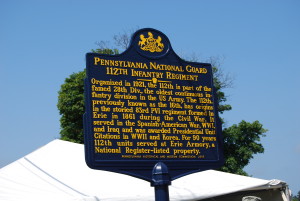Things To Do Now is an occasional series featuring tips and tricks for some of the SHPO’s most popular programs and projects.
 Think there is a person, place, or event in your community that deserves some recognition? If you believe that one of PHMC’s blue-and-gold historical markers is a great way to tell that story to the world, then keep reading for some tips (in no particular order)on what you can be doing right now to prepare an application for the next round of marker nominations. The deadline is December 1, 2015.
Think there is a person, place, or event in your community that deserves some recognition? If you believe that one of PHMC’s blue-and-gold historical markers is a great way to tell that story to the world, then keep reading for some tips (in no particular order)on what you can be doing right now to prepare an application for the next round of marker nominations. The deadline is December 1, 2015.
1. Contact PHMC staff to discuss a marker subject
It is helpful to discuss a proposed topic with the staff of the Marker Program prior to spending the time and effort to research and compile a nomination that may not meet the established Approval Criteria. We get lots of good applications every year, and unfortunately some are not approved. The marker nomination reviewers are interested in telling the stories of our past and commemorating the significant people, places, events, and innovations that touch the lives of Pennsylvanians.
Marker staff have a very good feel for what the panel is looking for in a marker topic and can review an application’s chances of success and provide tips on what points to emphasize. Subjects that are good candidates for a marker are those that have demonstrated historical significance beyond the local and/or regional level, tell a unique story, have a substantial connection to Pennsylvania, and are not well-covered by existing markers. PHMC is especially interested in encouraging markers for underrepresented subjects or in underrepresented regions in PA.
2. Secure a commitment for funding
The costs of fabricating and installing a new marker are the responsibility of the applicant/local sponsor, and it’s important to get a jump on fundraising early. Markers generally cost around $2,000, depending on size, and unfortunately PHMC is no longer able to provide financial assistance for these costs. Although the money is not required unless the marker is approved and completed, it is prudent to make sure the funding is available from an identified source. Townships or boroughs often agree to be sponsors for markers, as do local or county historical societies. Often businesses or corporations related to the marker subject are willing to sponsor a marker. Organizations or institutions that have an association to the marker subject have frequently come forward. On occasion, individual donors passionate about history or the particular subject donate the entire amount to sponsor a marker.
3. Get tentative permission from the property owner of the proposed marker site.
Following approval, PHMC requires that the nominator get a permission form signed by the property owner or representative who has authority over the property in question. It may seem premature to get verbal permission prior to submission of the nomination, but it will avoid problems or delays once you’ve been approved and want to move forward with planning. There have been instances of markers being approved and then the property owner refuses to allow installation at the proposed location. That requires the nominator to find an alternative location for the marker, which is usually not a problem, but can cause dedications to be postponed.
4. Select excerpts from several scholarly sources (primary and secondary) that you have consulted in your research.
Documentation is required to verify the claims made in the narrative portion of the nomination. The excerpts should directly support the points you have made and emphasize the subject’s statewide and/or national historical significance. Choose your documentation wisely, as you want to be thorough, but not include too many pages that will bog down those reviewing the nominations. Two sources that corroborate each other are good to include, and excerpts from many sources that provide identical information is unnecessary.
5. Submit draft nomination to PHMC staff for review and comment
It is generally helpful for a nominator to have PHMC staff evaluate a draft prior to submitting the final nomination. Staff can provide advice and suggest ways to adjust focus or sources to pursue that would afford one a better chance for approval. It is helpful to include the documentation you plan to provide with your nomination. A common shortcoming of unsuccessful nominations is lack of adequate documentation, so it can be very helpful to get feedback from PHMC staff. Draft nominations must be submitted at least one month prior to the annual December 1 deadline.
To learn more about the Marker Program, please visit our website pahistoricalmarkers.com.
Comment Policy
PHMC welcomes and encourages topic-related comments on this blog. PHMC reserves the right to remove comments that in PHMC’s discretion do not follow participation guidelines.
Commenters and Comments shall be related to the blog post topic and respectful of others who use this site.
Commenters and Comments shall not: use language that is offensive, inflammatory or provocative (this includes, but is not limited to, using profanity, obscene, or vulgar comments); disparage other commenters or people; condone illegal activity; identify the location of known or suspected archeological sites; post personal information in comments such as addresses, phone numbers, e-mail addresses or other contact details, which may relate to you or other individuals; impersonate or falsely claim to represent a person or an organization; make any commercial endorsement or promotion of any product, service or publication.
If you would like to comment on other topics not related to this blog post but related to PHMC, please fill out the PHMC Contact Us Form.






Leave a Reply